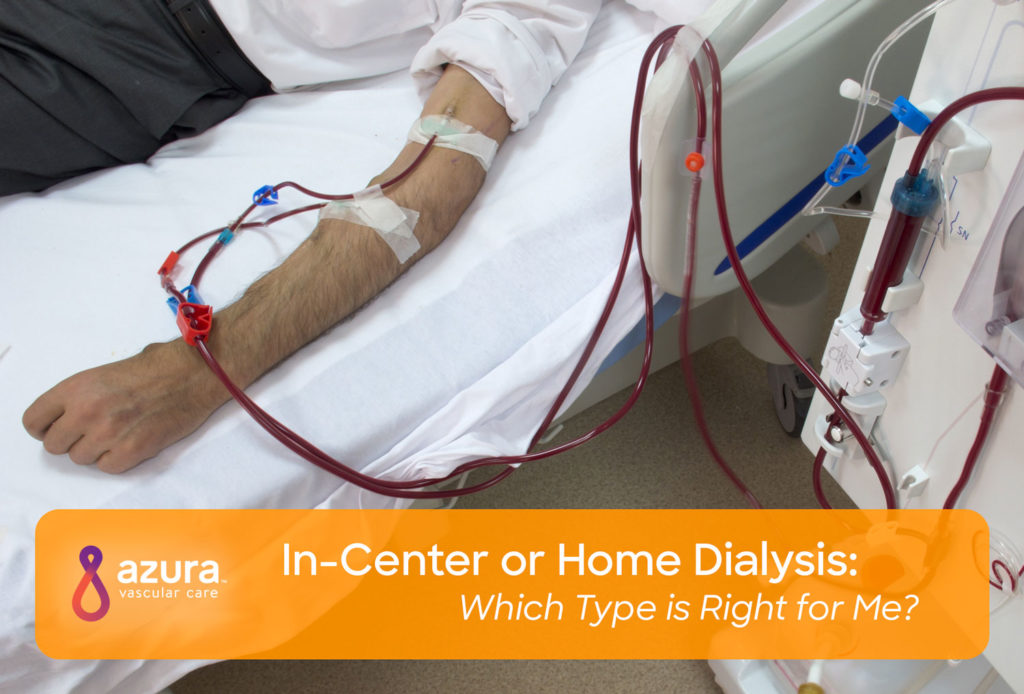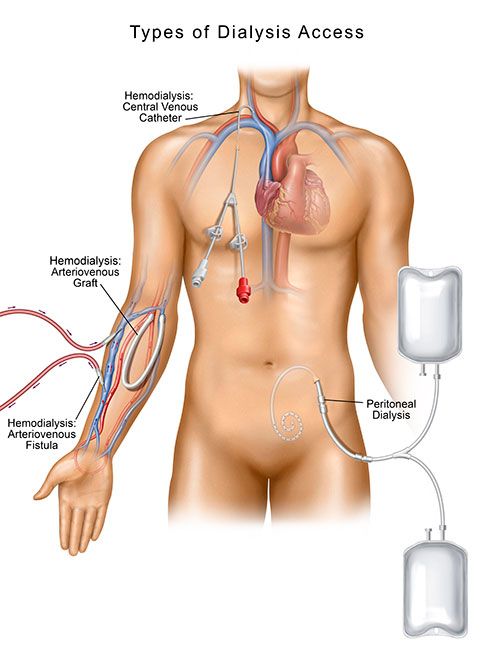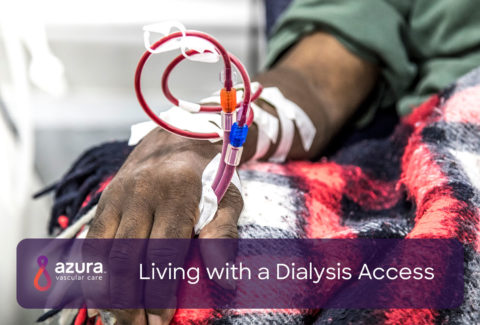
For patients with end-stage renal disease (ESRD), starting dialysis can be overwhelming. There is much to consider, leaving many patients with questions about their treatment options, such as, What dialysis modality is best for me? How often should I do dialysis? Where can I receive dialysis treatments? What access type is best? Can I continue to work while on dialysis? Read on to learn more.
Understanding Dialysis
If you have ESRD, your kidneys are no longer able to effectively filter waste and remove excess fluid from your blood. Dialysis, a lifesaving treatment, is needed to carry out the function of your kidneys. (i) Two types of dialysis modalities are used to treat kidney failure: hemodialysis and peritoneal dialysis. As you make decisions about your dialysis treatment, it’s important to have a basic understanding of how each modality works.
During hemodialysis treatment, a man-made membrane, also called a dialyzer, or an artificial kidney, is used to filter waste and remove extra fluid from your blood. Two needles are needed for hemodialysis: one removes the blood through the access sending it to the machine for filtering, another is needed to return the filtered blood back to the body.
Peritoneal dialysis uses the lining of your abdomen as the filter and a solution, known as dialysate, to remove the waste and extra fluid from your body. (ii) Peritoneal dialysis is performed at home after you, and in some cases a partner, are trained. No needles are involved with this type of dialysis and daily dialyzing is required. Storage space is needed for the supplies used during treatment.
Before initiating dialysis, patients must have a dialysis access created or placed. Hemodialysis patients will have an access surgically created in their arm or leg using their own native vessels for an AV fistula. For an AV graft, a biocompatible, synthetic tube will be placed. Peritoneal dialysis patients will undergo a minimally invasive surgical procedure to place a catheter in their abdomen as the dialysis access before beginning treatment.

To summarize, peritoneal dialysis is performed at home. Hemodialysis can be performed in a dialysis clinic or in the comfort of your own home. Let’s further explore in-center and home dialysis and what you can expect as a patient.
In-Center Hemodialysis
In-center hemodialysis takes place in a dialysis center, a medical facility with personnel specially trained in delivering dialysis treatment. Patients typically need to visit the dialysis center three times a week for treatment. Treatment time is usually between three and four hours. (ii)
In-center hemodialysis has several advantages:
- Dialysis care is overseen by a team of trained medical professionals. (iii)
- Treatment, labs and patient assessment are performed at the same location. (iii)
- The patient can relax, read, watch tv or socialize with patients and staff at the dialysis center.
In-center hemodialysis also has significant disadvantages:
- Patients must travel to the center for treatment.
- Treatment times may be inflexible and limiting.
- Because treatments are administered three times weekly, the patient must follow a prescribed diet between sessions and strictly limit fluid intake.
- Patients may have little privacy during treatment.
Home Dialysis
Patients who prefer to avoid visiting a medical facility may want to explore their options for home dialysis. Hemodialysis or peritoneal dialysis are both options for home dialysis.
With home hemodialysis, the patient and/or a caregiver provide the services that are performed by the dialysis team by connecting the patient to the dialyzer to receive treatment via needles in the access site. For some patients, peritoneal dialysis is the preferred choice as this type of dialysis allows blood to be cleaned inside the body without the use of needles. (iv)
Advantages of home dialysis include:
- Patients receive treatment in the comfort of their own home; time is not wasted traveling to a dialysis clinic.
- Patients are in charge of their treatment and can enjoy a more flexible schedule.
- Patients opting for peritoneal dialysis dialyze daily and experience a gentler treatment since it mimics more closely the natural function of a kidney which works 24/7.
- Peritoneal dialysis minimizes the excess accumulation of waste in the body and also leads to less dietary and fluid restrictions.
- Patients are not exposed to other patients who may be sick.
Disadvantages of home dialysis include:
- Patients must oversee their own treatment at home.
- Home dialysis equipment and supply storage space are needed.
- Patients may need a trained helper with them during treatments.
No matter which type of dialysis you choose, you will first need to have a dialysis access created or placed. This will require a minimally invasive surgical procedure that can be safely performed on an outpatient basis in most cases. The procedure you’ll undergo will depend on the type of dialysis access you will be using.
Caring for Your Access
Starting dialysis means making choices. It’s important to consider your personal preferences and priorities so you can decide which treatment will best meet your needs.
No matter which option you select—hemodialysis or peritoneal dialysis—you will need to take good care of your access. Each access type carries some risk of infection or clotting. These potential complications may disrupt your dialysis treatment schedule and lead to other associated problems. (v) If your dialysis access becomes dysfunctional, the staff at a vascular access center can provide the treatment you need to restore your access to full functionality.
Sources:
(i) National Institute of Diabetes and Digestive and Kidney Diseases. (n.d.) Hemodialysis. Retrieved September 24, 2018, from https://www.niddk.nih.gov/health-information/kidney-disease/kidney-failure/hemodialysis
(ii) Stanford Health Care. (n.d.). Types of dialysis. Retrieved September 27, 2018, from https://stanfordhealthcare.org/medical-treatments/d/dialysis/types.html
(iii) Fresenius Kidney Care. (n.d.) In-Center Treatment. Retrieved October 18, 2018, from https://www.freseniuskidneycare.com/ckd-treatment/in-center-hemodialysis/treatment-options
(iv) National Kidney Foundation. (2017). Dialysis. Retrieved September 27, 2018, from https://www.kidney.org/atoz/content/dialysisinfo
(v) National Kidney Foundation. (2017). Key points: About dialysis for kidney failure. Retrieved September 27, 2018, from https://www.kidney.org/patients/peers/dialysis.
(vi) Fresenius Kidney Care. (n.d.) Choosing the best dialysis access. Retrieved December 5, 2018, from https://www.freseniuskidneycare.com/ckd-treatment/types-of-dialysis-access.


